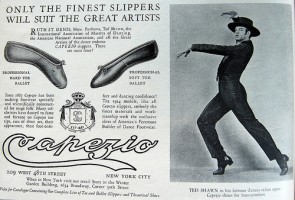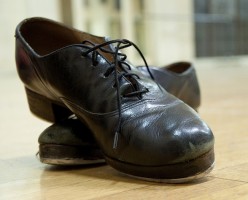Capezio

Salvatore Capezio opened his first store in New York City in 1887, the sign above the door reading The Theatrical and Historical Shoemaker. Located diagonally across from the old Metropolitan Opera House, Capezio made a name for himself repairing pointe shoes for the Met’s dancers. Capezio tried his hand at dance shoe construction and, appreciating the challenge of combining his cobbler expertise with the complex engineering of dance shoes, Capezio made the transition from cobbler to shoemaker.
Today, Capezio is considered by many to be the leading brand producing shoes for dance as well as dance wear. What began with pointe shoes has now expanded to soft ballet, jazz, modern/contemporary, TAP, character and theatre dance, as well as offering a full line of bodywear, legwear and accessories. Though spread out across the globe, Capezio has kept up it’s homely pretense of being a “family business” by involving family members in almost every aspect of the enterprise. The company’s reputation for maintaining long-lasting professional relationships and willingness to produce custom orders for individuals is well known.
Capezio Tap Shoes
Receiving my first pair of Capezio K360s as a child felt like an initiation into the the larger tap community. At the time, all of the best tap dancers were wearing the K360, or “Kays” as they are affectionately called, and soon all the best tap dancers in my studio had a pair. The Kays were heavy, both in weight and in price tag, and pressure to use them was a task that I was delighted to undertake.

Recently there has been an undercurrent of disapproval for the Capezio K360. Claims that the quality has dropped while the price has risen has caused much movement in the tap shoe industry. Hearing the outcries of distressed dancers, other companies have stepped up to the plate to appease the rising number of tap dancers looking for professional level shoes, in particular Bloch and So Danca. Regardless, many dancers still stick with their Kays claiming that, while admitting frustration with the manufacturer, that the Capezio K360 is so far ahead of the game that it is still the optimal choice for advanced and professional level tap dancers.
The way I see it, a chain is only as strong as its weakest link. While the K360 may be the reigning king of tap shoes, we must not forget that they have an extensive line of tap shoes to choose from. As a professional tap dancer I always wondered if the shoes make the man, or vice versa, and the only way to find out is to wear them and practice in them myself.
For information regarding key terms, types of tap shoes, shoe making materials and shoe making procedures, please refer to the previous TAPography articles in The Great Tap Shoeganza, whose table of contents can be found at Introducing The Great Tap Shoeganza!
Tristan Bruns has studied the art form of tap dance with Donna Johnson, Ted Levy, Lane Alexander and Martin “Tre” Dumas and has a BA in Music from Columbia College Chicago. Tristan has been an ensemble member of such Chicago tap companies as BAM!, The Cartier Collective and MADD Rhythms. Tristan currently produces his own work through his company, TapMan Productions, LLC, which includes the performance ensemble The Tapmen and the tap and guitar “band” of The Condescending Heroes.

